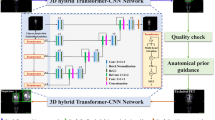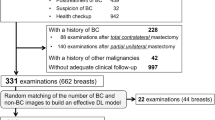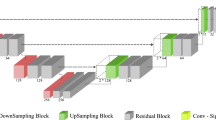Abstract
Background
Dedicated breast positron emission tomography (dbPET) has high contrast and resolution optimized for detecting small breast cancers, leading to its noisy characteristics. This study evaluated the application of deep learning to the automatic segmentation of abnormal uptakes on dbPET to facilitate the assessment of lesions. To address data scarcity in model training, we used collage images composed of cropped abnormal uptakes and normal breasts for data augmentation.
Methods
This retrospective study included 1598 examinations between April 2015 and August 2020. A U-Net-based model with an uptake shape classification head was trained using either the original or augmented dataset comprising collage images. The Dice score, which measures the pixel-wise agreement between a prediction and its ground truth, of the models was compared using the Wilcoxon signed-rank test. Moreover, the classification accuracies were evaluated.
Results
After applying the exclusion criteria, 662 breasts were included; among these, 217 breasts had abnormal uptakes (mean age: 58 ± 14 years). Abnormal uptakes on the cranio-caudal and mediolateral maximum intensity projection images of 217 breasts were annotated and labeled as focus, mass, or non-mass. The inclusion of collage images into the original dataset yielded a Dice score of 0.884 and classification accuracy of 91.5%. Improvement in the Dice score was observed across all subgroups, and the score of images without breast cancer improved significantly from 0.750 to 0.834 (effect size: 0.76, P = 0.02).
Conclusions
Deep learning can be applied for the automatic segmentation of dbPET, and collage images can improve model performance.




Similar content being viewed by others
Data availability
Data and materials are available for research purposes from the corresponding author upon reasonable request.
References
Hatazawa J. The clinical value of breast specific gamma imaging and positron imaging: an update. Semin Nucl Med. 2022;52:619–27. https://doi.org/10.1053/j.semnuclmed.2022.02.005.
Satoh Y, Motosugi U, Imai M, Onishi H. Comparison of dedicated breast positron emission tomography and whole-body positron emission tomography/computed tomography images: a common phantom study. Ann Nucl Med. 2020;34:119–27. https://doi.org/10.1007/s12149-019-01422-0.
Satoh Y, Motosugi U, Omiya Y, Onishi H. Unexpected abnormal uptake in the breasts at dedicated breast PET: incidentally detected small cancers or nonmalignant features? AJR Am J Roentgenol. 2019;212:443–9. https://doi.org/10.2214/AJR.18.20066.
Sasada S, Masumoto N, Kimura Y, Emi A, Kadoya T, Okada M. Classification of abnormal findings on ring-type dedicated breast pet for the detection of breast cancer. Anticancer Res. 2020;40:3491–7. https://doi.org/10.21873/anticanres.14336.
Masumoto N, Kadoya T, Sasada S, Emi A, Arihiro K, Okada M. Intratumoral heterogeneity on dedicated breast positron emission tomography predicts malignancy grade of breast cancer. Breast Cancer Res Treat. 2018;171:315–23. https://doi.org/10.1007/s10549-018-4791-1.
Sakaguchi R, Kataoka M, Kanao S, Miyake KK, Nakamoto Y, Sugie T, et al. Distribution pattern of FDG uptake using ring-type dedicated breast PET in comparison to whole-body PET/CT scanning in invasive breast cancer. Ann Nucl Med. 2019;33:570–8. https://doi.org/10.1007/s12149-019-01364-7.
Nishimatsu K, Nakamoto Y, Miyake KK, Ishimori T, Kanao S, Toi M, et al. Higher breast cancer conspicuity on DbPET compared to WB-PET/CT. Eur J Radiol. 2017;90:138–45. https://doi.org/10.1016/j.ejrad.2017.02.046.
Sasada S, Shiroma N, Goda N, Kajitani K, Emi A, Masumoto N, et al. The relationship between ring-type dedicated breast PET and immune microenvironment in early breast cancer. Breast Cancer Res Treat. 2019;177:651–7. https://doi.org/10.1007/s10549-019-05339-0.
Sasada S, Kimura Y, Masumoto N, Emi A, Kadoya T, Arihiro K, et al. Breast cancer detection by dedicated breast positron emission tomography according to the World Health Organization classification of breast tumors. Eur J Surg Oncol. 2021;47:1588–92. https://doi.org/10.1016/j.ejso.2021.02.026.
Satoh Y, Hirata K, Tamada D, Funayama S, Onishi H. Texture analysis in the diagnosis of primary breast cancer: comparison of high-resolution dedicated breast positron emission tomography (DbPET) and whole-body PET/CT. Front Med. 2020;7:603303. https://doi.org/10.3389/fmed.2020.603303.
Satoh Y, Tamada D, Omiya Y, Onishi H, Motosugi U. Diagnostic performance of the support vector machine model for breast cancer on ring-shaped dedicated breast positron emission tomography images. J Comput Assist Tomogr. 2020;44:413–8. https://doi.org/10.1097/RCT.0000000000001020.
Urso L, Manco L, Castello A, Evangelista L, Guidi G, Castellani M, et al. PET-derived radiomics and artificial intelligence in breast cancer: a systematic review. Int J Mol Sci. 2022;23:13409. https://doi.org/10.3390/ijms232113409.
Dwibedi D, Misra I, Hebert M. Cut, paste and learn: surprisingly easy synthesis for instance detection. IEEE Int Conf Comput Vis. 2017;2017:1310–9.
Seyfiouglu MS, Liu Z, Kamath P, Gangolli S, Wang S, Grabowski T, et al. 2022 Brain-aware replacements for supervised contrastive learning in detection of Alzheimer’s disease. ArXiv. 13431: 461–70.
Tsuda T, Murayama H, Kitamura K, Yamaya T, Yoshida E, Omura T, et al. A four-layer depth of interaction detector block for small animal PET. IEEE Trans Nucl Sci. 2004;51:2537–42. https://doi.org/10.1109/TNS.2004.835739.
Miyake KK, Kataoka M, Ishimori T, Matsumoto Y, Torii M, Takada M, et al. A proposed dedicated breast PET lexicon: standardization of description and reporting of radiotracer uptake in the breast. Diagnostics. 2021. https://doi.org/10.3390/diagnostics11071267.
Zhang H, Cissé M, Dauphin Y, Lopez-Paz D. 2017 Mixup: beyond empirical risk minimization. arXiv preprint doi:https://doi.org/10.48550/arXiv.1710.09412.
Ronneberger O, Fischer P, Brox T. U-Net: convolutional networks for biomedical image segmentation. doi:https://doi.org/10.48550/arXiv.1505.04597.
Tan M, Le QV. EfficientNet: rethinking model scaling for convolutional neural networks. doi:https://doi.org/10.48550/arXiv.1905.11946.
Salehi SSM, Erdoğmuş D, Gholipour A. Tversky loss function for image segmentation using 3D fully convolutional deep networks. doi:https://doi.org/10.48550/arXiv.1706.05721.
Dice LR. Measures of the amount of ecologic association between species. Ecology. 1945;26:297–302. https://doi.org/10.2307/1932409.
Yun S, Han D, Chun S, Oh SJ, Yoo YJ, Choe J. CutMix: regularization strategy to train strong classifiers with localizable features. IEEE/CVF Int Conf Comput Vis. 2019;2019:6022–31.
Welch HG, Prorok PC, O’Malley AJ, Kramer BS. Breast-cancer tumor size, overdiagnosis, and mammography screening effectiveness. N Engl J Med. 2016;375:1438–47. https://doi.org/10.1056/NEJMoa1600249.
Satoh Y, Motosugi U, Imai M, Omiya Y, Onishi H. Evaluation of image quality at the detector’s edge of dedicated breast positron emission tomography. EJNMMI Phys. 2021;8:5. https://doi.org/10.1186/s40658-020-00351-6.
Satoh Y, Imai M, Ikegawa C, Hirata K, Abo N, Kusuzaki M, et al. Effect of radioactivity outside the field of view on image quality of dedicated breast positron emission tomography: preliminary phantom and clinical studies. Ann Nucl Med. 2022;36:1010–8. https://doi.org/10.1007/s12149-022-01789-7.
Satoh Y, Imokawa T, Fujioka T, Mori M, Yamaga E, Takahashi K, et al. Deep learning for image classification in dedicated breast positron emission tomography (DbPET). Ann Nucl Med. 2022;36:401–10. https://doi.org/10.1007/s12149-022-01719-7.
Author information
Authors and Affiliations
Contributions
All authors contributed to the study conception and design. Material preparation and data collection were performed by TI, YS, and TF. Coding and analysis were performed by TI and KT. The first draft of the manuscript was written by TI. All authors commented on the manuscript. All authors read and approved the final manuscript.
Corresponding author
Ethics declarations
Conflict of interest
The authors of this manuscript declare no relationships with any companies whose products or services may be related to the subject matter of the article.
Ethical approval
This study was approved by the review board of Kofu Neurosurgical Hospital (approval date: October 12, 2021).
Informed consent
Written informed consent for 18F-FDG PET/CT was obtained from all patients.
Additional information
Publisher's Note
Springer Nature remains neutral with regard to jurisdictional claims in published maps and institutional affiliations.
Supplementary Information
Below is the link to the electronic supplementary material.
About this article
Cite this article
Imokawa, T., Satoh, Y., Fujioka, T. et al. Deep learning model with collage images for the segmentation of dedicated breast positron emission tomography images. Breast Cancer (2023). https://doi.org/10.1007/s12282-023-01492-z
Received:
Accepted:
Published:
DOI: https://doi.org/10.1007/s12282-023-01492-z




